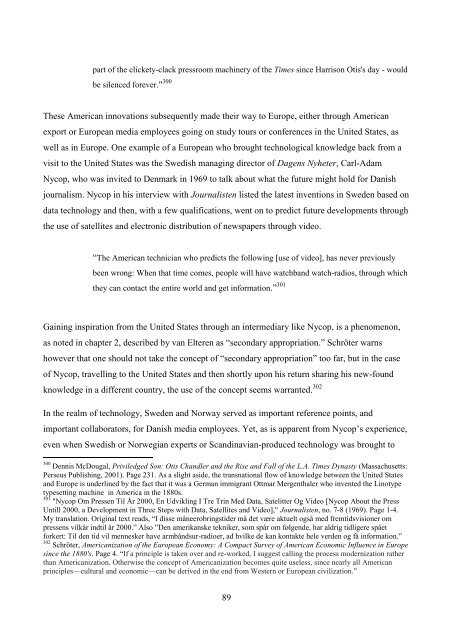The Jeremiad Over Journalism
The Jeremiad Over Journalism
The Jeremiad Over Journalism
You also want an ePaper? Increase the reach of your titles
YUMPU automatically turns print PDFs into web optimized ePapers that Google loves.
part of the clickety-clack pressroom machinery of the Times since Harrison Otis's day - would<br />
be silenced forever." 300<br />
<strong>The</strong>se American innovations subsequently made their way to Europe, either through American<br />
export or European media employees going on study tours or conferences in the United States, as<br />
well as in Europe. One example of a European who brought technological knowledge back from a<br />
visit to the United States was the Swedish managing director of Dagens Nyheter, Carl-Adam<br />
Nycop, who was invited to Denmark in 1969 to talk about what the future might hold for Danish<br />
journalism. Nycop in his interview with Journalisten listed the latest inventions in Sweden based on<br />
data technology and then, with a few qualifications, went on to predict future developments through<br />
the use of satellites and electronic distribution of newspapers through video.<br />
―<strong>The</strong> American technician who predicts the following [use of video], has never previously<br />
been wrong: When that time comes, people will have watchband watch-radios, through which<br />
they can contact the entire world and get information.‖ 301<br />
Gaining inspiration from the United States through an intermediary like Nycop, is a phenomenon,<br />
as noted in chapter 2, described by van Elteren as ―secondary appropriation.‖ Schröter warns<br />
however that one should not take the concept of ―secondary appropriation‖ too far, but in the case<br />
of Nycop, travelling to the United States and then shortly upon his return sharing his new-found<br />
knowledge in a different country, the use of the concept seems warranted. 302<br />
In the realm of technology, Sweden and Norway served as important reference points, and<br />
important collaborators, for Danish media employees. Yet, as is apparent from Nycop‘s experience,<br />
even when Swedish or Norwegian experts or Scandinavian-produced technology was brought to<br />
300 Dennis McDougal, Priviledged Son: Otis Chandler and the Rise and Fall of the L.A. Times Dynasty (Massachusetts:<br />
Perseus Publishing, 2001). Page 231. As a slight aside, the transnational flow of knowledge between the United States<br />
and Europe is underlined by the fact that it was a German immigrant Ottmar Mergenthaler who invented the Linotype<br />
typesetting machine in America in the 1880s.<br />
301 "Nycop Om Pressen Til År 2000, En Udvikling I Tre Trin Med Data, Satelitter Og Video [Nycop About the Press<br />
Untill 2000, a Development in Three Steps with Data, Satellites and Video]," Journalisten, no. 7-8 (1969). Page 1-4.<br />
My translation. Original text reads, ―I disse måneerobringstider må det være aktuelt også med fremtidsvisioner om<br />
pressens vilkår indtil år 2000.‖ Also ‖Den amerikanske tekniker, som spår om følgende, har aldrig tidligere spået<br />
forkert: Til den tid vil mennesker have armbåndsur-radioer, ad hvilke de kan kontakte hele verden og få information.‖<br />
302 Schröter, Americanization of the European Economy: A Compact Survey of American Economic Influence in Europe<br />
since the 1880's. Page 4. ―If a principle is taken over and re-worked, I suggest calling the process modernization rather<br />
than Americanization. Otherwise the concept of Americanization becomes quite useless, since nearly all American<br />
principles—cultural and economic—can be derived in the end from Western or European civilization.‖<br />
89
















